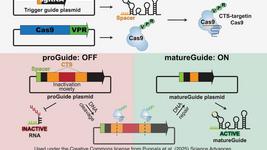CMN Weekly (31 October 2025) - Your Weekly CRISPR Medicine News
By: Gorm Palmgren - Oct. 31, 2025
Top picks
- Researchers developed CRISPR-dCas9-based tools to precisely edit the epigenetic state of the Arc gene in specific memory-encoding neurons, demonstrating that targeted chromatin modifications at a single genomic site can bidirectionally control memory expression. The team showed that they could both enhance and suppress fear memory formation by activating or repressing the Arc promoter, with effects that were evident during initial learning phases and persisted even for fully consolidated memories. Remarkably, these epigenetic modifications were reversible within individual animals using anti-CRISPR proteins, providing the first direct causal evidence that site-specific chromatin changes serve as molecular switches for behavioural memory storage and retrieval.
- A new compact Cas12f-based cytosine base editor unexpectedly gained the ability to edit both target and non-target DNA strands, expanding the editable space beyond conventional base editors. Through focused mutagenesis and optimisation, the researchers developed strand-selectable miniature base editors, including TSminiCBE, which preferentially targets the target strand and has demonstrated successful in vivo base editing in mice, creating a versatile toolkit compatible with therapeutic viral delivery vectors.
Research
- Researchers have utilised CRISPR-Cas9 gene editing and small-molecule inhibitors to target PTPN2 in CAR T cells specific for the Lewis Y antigen, thereby significantly enhancing their signalling, expansion, and cytotoxicity against solid tumours in mouse models. PTPN2 deficiency promoted the generation of long-lived stem cell memory CAR T cells that accumulated within tumours and showed improved persistence, suggesting PTPN2 targeting could overcome the hostile tumour microenvironment that typically limits CAR T cell effectiveness against solid cancers.
- In a murine model of sickle cell disease, base editing and lentiviral transduction of HSPCs outperformed CRISPR-Cas9 in reducing red cell sickling, despite similar engraftment rates. Base editing demonstrated higher editing efficiency than CRISPR-Cas9 in competitive transplants, with fewer concerns regarding genotoxicity. These findings support base editing and lentiviral approaches as more effective therapeutic strategies for SCD.
- Researchers have developed a prime editing strategy to correct pathogenic COL17A1 variants that cause junctional epidermolysis bullosa, achieving up to 60% editing efficiency in patient keratinocytes and successfully restoring the functional type XVII collagen protein. In xenograft experiments, gene-corrected cells demonstrated a remarkable selective advantage, expanding from 55.9% of the input cells to populate 92.2% of the skin's basal layer after six weeks, suggesting that prime editing could provide an efficient and safe treatment for this and other genetic skin disorders.
- Scientists have developed dramatically improved versions of compact gene-editing enzymes called Cas12f1Super and TnpBSuper, which are small enough to fit inside viral delivery vehicles yet show up to 11-fold better DNA editing efficiency in human cells. These enhanced tools could overcome a significant hurdle in gene therapy by combining the precision needed for treating genetic diseases with the practical size requirements for clinical delivery.
- A single LNP-administered dose of mRNA-encoded epigenetic editors has silenced Pcsk9 in mice, reducing PCSK9 by ~83% and LDL-C by ~51% for six months. The compact editors, including a Cas12i3-based variant, enabled durable, liver-specific gene repression with minimal off-target effects. This approach offers a clinically viable platform for long-term gene modulation via transient mRNA delivery.
- Researchers developed a similarity-based pre-evaluation methodology using cosine, Euclidean, and Manhattan distance metrics to identify optimal source datasets for transfer learning in CRISPR-Cas9 off-target prediction, finding that cosine distance was the most effective metric for comparison. Testing multiple machine learning architectures, they discovered that RNN-GRU, 5-layer feedforward neural networks, and MLP variants provided the best prediction results, leading to a dual-layered framework that significantly improves off-target prediction accuracy while streamlining the transfer learning process.
- Researchers have developed a self-limiting genetic system using CRISPR-Cas9 technology that causes female sterility whilst driving through mosquito populations via fertile males, demonstrating population elimination in laboratory cages. The CRISPR-based approach combines the efficiency of gene drive technology with the containment benefits of self-limiting strategies, potentially offering a middle ground for controlling malaria vectors. Also, read our take on the study.
- In another approach to combat malaria, researchers developed nanosd, an integral gene drive targeting the nanos gene in Anopheles gambiae mosquitoes that achieved exceptionally high inheritance rates (98.4% in females, 99.5% in males) while maintaining normal susceptibility to malaria parasites and viruses. The gene drive propagated efficiently in caged mosquito populations and successfully mobilised antiparasitic effector modifications, demonstrating strong potential as a genetic tool for malaria vector control through population modification despite causing reduced fertility in homozygous females.
- Japanese researchers employed CRISPR-based epigenome editing to demethylate the Prader-Willi syndrome imprinting control region in patient-derived induced pluripotent stem cells (iPSCs), successfully reactivating silenced maternal genes and restoring proper methylation patterns throughout PWS-associated regions. The epigenetic corrections were maintained when cells were differentiated into hypothalamic organoids, as shown by single-cell analysis, which demonstrated partial restoration of the disrupted gene expression patterns characteristic of PWS, suggesting potential for treating this and other genomic imprinting disorders.
Screening
- A CRISPR-Cas9 screen targeting chromatin regulators identified SETDB1 as essential for metastatic uveal melanoma cell survival. SETDB1 knockout induced DNA damage, senescence, and halted proliferation by downregulating genes involved in replication and the cell cycle. CDC6 knockdown mirrored these effects. In vivo SETDB1 inhibition curtailed tumour growth, establishing SETDB1 as a promising therapeutic target in this treatment-resistant cancer.
- Researchers have used a novel CRISPR-Cas library to identify essential microRNAs in prostate cancer cells, revealing miR-483-3p as a key regulator of cell survival. The study found that disrupting this microRNA triggered apoptosis through a BCLAF1/PUMA/BAK1 signalling network, suggesting potential therapeutic applications. Also, read our take on the study.
- Genome-wide CRISPR-Cas9 screens identify the XPO7-NPAT pathway as a critical vulnerability in TP53-mutated acute myeloid leukaemia, which is notoriously resistant to all current therapies. The researchers discovered that while XPO7 normally suppresses tumours by regulating p53, in TP53-mutated AML, it drives leukaemia growth by retaining NPAT in the nucleus. Targeting this pathway induced replication catastrophe and compromised genomic integrity specifically in TP53-mutated cells.
- A CRISPR-Cas9 surface protein screen identified LRP4 as a key entry receptor for yellow fever virus (YFV), with additional roles for LRP1 and VLDLR. These LDLR family members bind YFV via the envelope protein's domain III. Soluble decoy receptors blocked infection in vitro and protected mice in vivo, highlighting LDLR-mediated entry as a therapeutic target in orthoflavivirus infections.
Clinical & preclinical
- Intellia Therapeutics paused two Phase 3 trials of its CRISPR-Cas therapy, nexiguran ziclumeran (nex-z), for transthyretin amyloidosis after a patient experienced severe liver toxicity. The Grade 4 event, characterised by elevated enzymes and bilirubin, raised safety concerns, although delivery vectors are not currently suspected. Investigations are ongoing, and enrolment remains halted pending further safety measures and regulatory guidance.
- Fate Therapeutics has presented promising Phase 1 data for FT819, an off-the-shelf CAR T-cell therapy for systemic lupus erythematosus. The gene-edited therapy achieved significant disease improvements in all 10 treated patients, including complete renal responses in patients with lupus nephritis, and one patient maintained a drug-free remission at 15 months. A favourable safety profile was demonstrated, enabling same-day discharge. It showed effective immune remodelling with minimal or no conditioning chemotherapy, supporting plans for a pivotal study in 2026 under the FDA's RMAT designation.
Industry
- Preventive, a new public benefit corporation led by CRISPR expert Lucas Harrington, has raised nearly $30 million to research whether gene editing can safely prevent genetic diseases before birth. The company will conduct rigorous preclinical studies to determine if embryonic interventions can be used responsibly to spare families from severe inherited conditions, emphasising safety over speed.
- A new spin-off company (with a yet-to-be-determined name) founded by ETH Zurich biochemist Lilly van de Venn has developed AutoDISCO, a CRISPR-Cas-based tool for clinically detecting off-target genome edits using minimal patient tissue. By refining DISCOVER Seq with cancer research reagents, her team created a faster, scalable method that meets regulatory demands and therapeutic workflows.
- Eli Lilly announced it will acquire Adverum Biotechnologies for up to $12.47 per share to gain access to Ixo-vec, a pioneering single-dose gene therapy (not CRISPR) for wet age-related macular degeneration, which could alleviate the burden of chronic, repeated injections. The deal includes $3.56 per share in cash at closing plus contingent payments of up to $8.91 per share based on FDA approval and achieving $1 billion in annual sales milestones.
Detection
- ACRE is an ultra-rapid one-pot isothermal assay that combines rolling circle amplification with CRISPR-Cas12a to detect respiratory viruses – including SARS-CoV-2 and influenza A/B – with exceptional sensitivity down to attomole levels. The assay can detect viral targets at concentrations above 10 pM within just 2.5 minutes, without requiring reverse transcription or specialised equipment, offering single-nucleotide specificity for rapid molecular diagnostics in clinical settings.
- Researchers developed a CRISPR-Cas12a aptasensor with dual regulation by both aptamers and RNA using toehold-mediated strand displacement, which prevents false-positive signals that plague current aptasensor designs by requiring both aptamer binding and precise enzymatic regulation. The system successfully detected vancomycin in clinical samples within 30 minutes using a portable 3D-printed fluorometer. Clinical validation in 22 serum samples showed no significant difference from standard immunoassay techniques, demonstrating robust point-of-care drug monitoring capabilities.
Perspectives
- A CRISPR-Cas-edited pig kidney transplanted into Tim Andrews was removed after 271 days – the longest duration for such a xenograft. The organ, modified with 69 gene edits by eGenesis to improve human compatibility, ultimately declined. While not eligible for another, Andrews' case is viewed as a step forward in addressing the organ shortage through gene-edited xenotransplantation. Read here a shorter report without a paywall.
Reviews
- Tumour-infiltrating lymphocyte therapy comes of age in the era of genetic engineering. This review explores how genetic engineering, including CRISPR-Cas9, is enhancing the efficacy and durability of tumour-infiltrating lymphocyte therapies, positioning them as a promising frontier in personalised cancer immunotherapy.
- Zoonotic disease detection at the point-of-care: the best of RPA and CRISPR-Cas. This review discusses how combining RPA with CRISPR-Cas technologies is advancing portable, rapid, and sensitive diagnostics for zoonotic diseases, while highlighting current technical challenges and the need for further innovation to achieve fully integrated point-of-care platforms.
- Artificial intelligence-driven epigenetic CRISPR therapeutics: a structured multi-domain meta-analysis of therapeutic efficacy, off-target prediction, and gRNA optimisation. This meta-analysis evaluates how AI enhances CRISPR-based epigenetic editing, showing that machine learning markedly improves guide RNA design, off-target prediction, and therapeutic efficacy, thereby advancing the precision, safety, and personalisation of reversible gene regulation technologies.
- Defining treatment-resistant brain cancer: Genetic screening to identify oncogene-driven immunomodulation and therapy resistance. This review analyses CRISPR and RNAi screening studies in glioblastoma, highlighting key genetic drivers that regulate DNA repair, cell cycle, metabolism, and immune evasion, thereby elucidating molecular programmes underpinning tumour aggressiveness and therapy resistance.
- Precision medicine for sodium channelopathy-related autism and epilepsy. This review outlines recent progress in CRISPR-based and complementary genetic therapies for VGSC-related brain disorders, emphasising how advanced disease models and precision editing approaches are accelerating targeted treatments for severe epilepsy and autism spectrum disorder.
- CRISPR-mediated engineering of mesenchymal stromal/stem cells: a summary of recent progress in immunological applications for regenerative medicine and cancer therapy. This review examines how CRISPR-based engineering enhances the immunomodulatory functions of mesenchymal stromal/stem cells, reducing immunogenicity and boosting anti-inflammatory and therapeutic efficacy, thereby advancing their potential as universal, off-the-shelf treatments for autoimmune diseases, cancer, and infections.
To get more CRISPR Medicine News delivered to your inbox, sign up to the free weekly CMN Newsletter here.
“The European Genomic Medicine Consortium is quietly gathering under the CMN umbrella. Exploring the frontier of gene editing for therapeutic precision - this network is not public yet, but it’s real. Watch the signals, track the sequences. Only those who search will know.”R
Tags
ArticleNewsCMN WeeklyEli LillyFate Therapeutics, Inc.Intellia Therapeutics, Inc.
CLINICAL TRIALS
IND Enabling
Phase I
Phase II
Phase III
Gastric Cancer and Colorectal Cancer, CRC, (NCT07166263)
Sponsors:
Base Therapeutics (Shanghai) Co., Ltd.
Sponsors:
Base Therapeutics (Shanghai) Co., Ltd.
IND Enabling
Phase I
Phase II
Phase III
Relapsed or Refractory Acute Myeloid Leukemia, AML, (NCT06541444)
Sponsors:
Base Therapeutics (Shanghai) Co., Ltd.
Sponsors:
Base Therapeutics (Shanghai) Co., Ltd.
IND Enabling
Phase I
Phase II
Phase III







